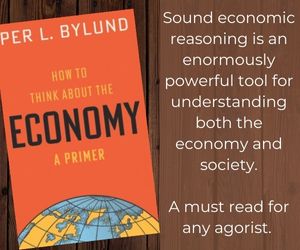
Counter-Economics: From the Back Alleys… To the Stars by SEK3 Reviewed by Wendy McElroy
Samuel Edward Konkin III or SEK3 (1947-2004) intended his book Counter-Economics: From the Back Alleys… To the Stars to be the crowning achievement of his 15+ years of writing, activism, and research about Agorism. Agorism is the unique anti-statist philosophy that SEK3 originated, expounded, and lived. The philosophy is realized through the strategy and lifestyle of Counter-Economics.
In the book’s Introduction, SEK3 defines Counter-Economics. “Counter-Establishment Economics is the study and practice of that part of human action committed in spite of the official legitimacy (government legislation).” It is “the theory and practice of all human action neither accepted by the State nor involving any initiatory violence or threat of violence.” In other words, Counter-Economics is the practical embrace of all non-coercive human action, with Agorism being its full realization as well as its philosophical underpinning.
The Introduction also provides the book’s purpose. It asks, “Are you reading a self-help book, a personal liberation manual, a financial advisory, an esoteric economics text, an anti-political platform, a muckraking history, a sensational exposé of underground life, or an anarchist cookbook?” It answers, “All of the above. That may sound confusing, but the main purpose of this writing is to extract unity from these topics usually unconnected in most minds today.” The book is a “self-help guide” to show “the reader what Counter-Economics is” in practice.
SEK3’s abrupt death on February 23, 2004 cut this plan short. The incomplete manuscript he left behind consists of the introduction by SEK3, six full chapters, and an outline of the remaining twelve. Reportedly, ten chapters had been written at the time of his death, but only six were found. Fortunately, the outline sketches the intended content of the missing chapters so there is a flow to how the ideas develop. The published book also includes an Appendix by SEK3 and an Afterword by Victor Koman who was, arguably, SEK3’s closest friend and remains a leading advocate of Agorism.
It is odd to review a book that is largely unwritten. Just one difficulty in doing so is that the content announced by the outline may well have morphed as SEK3 progressed toward a finished product. But it seems wrong for SEK3’s last work to gather dust rather than to circulate widely in whatever form exists. The world needs as much of this man to be publicized as we can recover.
Koman obviously agrees; his publishing venture KoPubCo issued an ebook version of Counter-Economics in 2019, which remains the only version. He did the strenuous work of scanning a manuscript that had been written on a typewriter with irregular keys; this means the process of correcting the scans was formidable. Koman also edited the book carefully to remove some of the outdated historical references that are inevitable in a work that is a third of a century old—and a fast-moving century, at that. Nevertheless, as Koman explains, “it turns out that even though the references are dated, the principals [sic] underpinning Counter-Economics are consistent and timely.”
This review reflects the same conclusion; historical references are mentioned only in passing or not at all, while the principles are highlighted. My reasons are different, however, because I also significantly disagree both with SEK3’s historical interpretations and with the reasoning behind their prominent inclusion. I believe the history detracts more than it adds to the presentation of Agorism.
My disagreement with SEK3 dates back to the friendly arguments he and I used to have over his contention that “the worse things get, the better things are.” As a society’s freedom deteriorated, he believed more people turn to Counter-Economics which draws them closer to Agorism and anarchy. The counter-economists may embrace the black market out of necessity rather than ideology, he conceded, but any motivation increased individual freedom. Chapter Three, “Soviet Counter–Economics,” explains what SEK3 calls a paradoxical truth. “A major premise of counter-economic theory is this: the more government intervention in the economy, the larger the Counter-Economy….So a positive test of our theory would be to check out a totalitarian State in some detail and observe the degree of counter-economic activity.”
This is why SEK3 devoted so much space to the economic history of totalitarian States, especially the Soviet Union.
The use of history is problematic in several ways and, since it is pivotal to the purpose of the book, it should be analyzed in some depth. One problem: it is impossible to measure the level of Counter-Economics within one State, let alone to compare it accurately to another as his theory requires. By definition, black market activities fly under the radar. A second problem: I do not find SEK3’s evidence to be convincing. The proofs of his theory skip along the surface of a huge, deep reservoir of history, and they follow the path of a pre-established assumption. The assumption may be correct, but SEK3 does not examine facts to tease out a conclusion. He begins with the conclusion and searches for supporting evidence. A third problem: he relies heavily upon unreliable sources such as newspaper reports that may be biased, inaccurate, or contradicted by competing accounts.
There is a larger difficulty, however. “The worse things get, the better things are”; if SEK3 means only that economic resistance to a State grows as that State becomes more repressive, then the word “better” is inappropriate because totalitarianism makes life a living hell. SEK3 means much more, however. Counter-Economics is defined to include all human action that is non-State and nonviolent, which means the word “better” applies not merely to economic activities under totalitarianism but to most of life. This is bizarre on at least two levels. First, it implies that freedom makes things “worse.” Second, a repressive State may drive despairing people to break the law by going Counter-Economic, but this does not mean worsening conditions make things better for them. It does not convert totalitarianism into a doorway to Agorism.
By contrast, I believe the worse things get, the worse things are; the better or freer things get, the better and freer things are.
SEK3’s theory should not be mistaken for an insensitivity to human suffering. His book is an expression of the opposite. Counter-Economics was written to improve people’s lives by teaching them “how they can resolve today’s controversies and guide tomorrow’s choices” in personal life and society at large. “I hope it will indeed amuse and excite the reader about another, accessible way of life, give new explanation to some of the vexing problems that beset our social life, and perhaps solve a few.”
Even the unfinished Counter-Economics has inspired people. Derrick Broze, author of How to Opt–Out of the Technocratic State, continues SEK3’s mission. His review of Counter-Economics explains “one of the most important aspects of Konkin’s final work is his desire to flesh out arguments against the psychological manipulation and propaganda of the State which has conditioned most people to feel wrong when they are breaking the law. Through the State indoctrination centers (aka public schools) the people have been conditioned to believe they should feel a sense of guilt if they do not report all of their income or make a voluntary exchange that does not involve feeding the government’s tax machine.”
Broze points to a unique aspect of SEK3’s book; it develops the psychology of Counter-Economics. SEK3 declares “the most dangerous idea of radical libertarianism” is not “voluntary alternatives to the State apparatus.” The most “dangerous is the moral idea that non-compliance with the State is good; one should not feel guilty of breaking the law to do what one wishes, one should feel proud!” Ending any shred of shame over being anti-statist or breaking the law is a precondition to Agorism.
Another precondition is the realization that Counter-Economics already pervades the society and should not be stigmatized as aberrant or abhorrent. It is a normal and prideful thing. Daily life is so regulated that breaking laws is an inevitability even for the regulators themselves; everyone acts counter-economically, whether in a trivial manner (e.g. crossing against a red light) or a major one (e.g. tax evasion). They become criminals. Whenever people do so, they increase freedom by decreasing respect for the State, even if this is not their conscious intent.
Most counter-economists are not anarchists or libertarians but people who want to enrich themselves or who resent the State’s intervention. Resentment of high taxes, for example, creates more counter-economists than ideological arguments. But, again, non-ideological intentions do not lessen the salutary impact of black market activity. “If a socialist or fascist or even one devoid of ideology or thought learns and applies counter-economic acts,” SEK3 maintains, “the purest libertarianism has been, to my mind, advanced. To that end, I have deliberately left the philosophical implications of Counter-Economics to the end of the book.”
Counter-Economics is prevalent not because of ideology so much as the innate human desire to prosper and be free. It is praxeology—the study of human action made popular by Ludwig von Mises—that renders the State impotent against Counter-Economics because the State cannot stop human nature. This does not mean that people understand the dynamics of their own freedom, however. The first task of an Agorist, therefore, is to instruct people on the how of Counter-Economics, and once they are active participants in freedom to educate them on why their actions are correct. Counter-Economics opens with how.
Chapter One: Tax Counter-Economics. The drug market and tax evasion are probably the greatest “recruiting and consciousness-raising” activities for Counter-Economics. Both are part of the “Underground Economy” that SEK3 deems “the most hard-core committed sector of the tax-law breakers of the Counter-Economy.” They form the largest sector of society’s underground. Presumably, they are hard core because their choices are not random, unconnected acts but constitute a sustained pattern of planned behavior. How does this work on a day-to-day basis?
Begin with economics. There are three common ways to go underground. The first is to keep transactions entirely “off the books”; back alley or handshake deals leave no paper trail. The second is to manipulate the books in order to hide profit and yet have something for the State to examine; this can be as simple as neglecting to enter some amount of the cash or income that is received. The third is to use double accounting. When double-accounting is done in order to hide money, one book is kept for tax purposes and reflects a lower income than is real, while a private one reflects the reality.
The first “off the books” method is the most common one used by individuals, and it almost always includes untraceable (or difficult to trace) money and complicity. “They [State agents] need records—and testimony.” If an illegal transaction is untraceable, the State cannot prove a crime occurred. This makes privacy a top priority for counter-economists. Ensuring a lack of testimony is essential because transactions involve other people who could be a danger. In the so-called white market of above-board transactions, “the complicity is, of course, bought outright with a discount”; it is common practice for service providers to give a cash buyer 10% off an advertised price. If people cooperate in an underground transaction, they become complicit because they are equally “guilty.” In some cases, as with drug dealers, “complicity may be purchased by the uniqueness of the product”; the only way to get a specific drug may be to go underground and share the risks. Barter also establishes complicity. The benefit of barter is not merely the profit gained by the participants but also the creation of other counter-economists. The indirect participants also move closer to Counter-Economics and away from the State. They consist of everyone who knows about a transaction and does not report it to authorities: family, friends, acquaintances, casual observers, those who hear about a transaction second-hand.
The second strategy of “manipulating the books” is more commonly used by businesses than by individuals. Skimming is prevalent in storefronts and restaurants, for example; that is, an owner pockets part of his income without recording the amount. (This differs from employees skimming because the money taken by the owner was honestly earned, not stolen.) Individuals can manipulate the books as well, however. SEK3 offers two examples. “One group of retirees collect winnings at race tracks for big-time bettors, then turn them over to their backers who avoid high-bracket income levels. Expense accounts can and do absorb all sorts of transactions to be kept off the personal income books.”
The third strategy of double accounting means people keep a set of books for themselves and one for the State. A person might pocket half of all cash income without reporting it. SEK3 quotes a California merchant who “boasts that he hasn’t paid 1 percent of income tax in five years.” The merchant advises, “The most important thing is consistency. If you skim, skim the same amount each year. If you let one year go by without taking anything off and then take 20 percent the next, you’re going to get caught.” Privacy and consistency are prudent for anyone who tampers with “the books.”
Chapter Two: International Counter-Economics. SEK3 moves from the personal to the global. An ideal world has no borders, only geography—rivers and mountains—that a successful entrepreneur must overcome in a competitive manner. International Counter-Economics arises “when the State imposes imaginary boundaries and real enforcers such as customs inspectors, immigration officers, and treasury agents—not to mention armies and navies.”
The International Counter-Economic market splits into two parts. A white market of legal goods sees the State as an obstacle that it overcomes through mechanisms such as bribery and loopholes. A black market of illegal goods avoids government. Both express Counter-Economics to a differing degree. And, then, there is Information, such as pirate broadcasting or industrial espionage, which is another form of “border-avoiding commerce.” Unfortunately, SEK3 provides little instruction on the ‘how’ of global Counter-Economics.
Instead, he explores the specific circumstances and history of various totalitarian States. In doing so, SEK3 asks an important question; “can the power of the State get so great that the counter-economy, rather than growing in response, gets crushed?” It is not fully answered, however, except through examples and conclusions.
Another interesting question is whether Counter-Economics can be used merely as a successful business model in order to maximize profits. The nub of the question is whether a scofflaw businessman will end up with a product or service that is “cheaper—far cheaper” than the law-abiding businessman. Is violating the law a prudent business model? If so, the profit-motive creates black marketeers who may become Agorists over time. Again, unfortunately, SEK3 promises to expand on this train of thought “at the end of the book.”
Chapter Three: Soviet Counter Economics. “A major premise of counter-economic theory is this: the more government intervention in the economy, the larger the Counter-Economy.” So opens Chapter Three. SEK3 is well aware that American conservatism argues the opposite view; namely, entrepreneurship is “almost snuffed out” by totalitarian communist regimes.
He asks, “What does reality say?” The reality SEK3 chooses to analyze for an answer is the Soviet Union, which he views as the hardest case for his theory. “Most observers will grant there is considerably more State intervention in, say, the Union of Soviet Socialist Republics than in the United States. Therefore, there should be more Counter-Economics, as well.” (Note: the preceding assumption works only if Counter-Economics is defined as anti-statist or contra-statist activity; if it is defined as non-statist, then there is no reason to believe a less powerful State would have less Counter-Economics than a totalitarian one. Indeed, I would expect there to be considerably more.)
Much of the Chapter presents snippet descriptions of the Soviet black market and or counter-economic anecdotes, which are presented as an indication of the norm. The State is presented as impotent or complicit. Instead of dealing with the accuracy of this portrayal of Soviet history, it is more interesting to focus on general insights and principles provided by the chapter.
For example, SEK3 notes a difference between North America’s Counter-Economy and that of the Soviet Union which shapes the two dynamics. North America’s consists mostly of “forbidden fruit” or for purposes of tax evasion. The Soviet one consists largely of consumer goods that are legal but are either not available or of far better quality than what is available from the State; this often means foreign goods that are smuggled. By contrast, North Americans take availability and high quality for granted.
The Soviet State’s reaction to the black market is fascinating. On one hand, the regime is threatened by “the huge scale of the parallel market activities” that damage “its control over the economy and the people.” But it recognizes that some black market activity is necessary to keep the economy running. Moreover, imposing additional laws on the parallel market creates more counter-economists because obedience becomes unprofitable and uncompetitive. Law-abiding people are pushed toward Counter-Economics simply to make a living, and this impacts their psychology. “Underground activities with their secret operations create far-reaching psychological consequences for large sectors of the Soviet populace. And private enterprise is absolutely inconsistent with an official communist ideology….What is significant here is the helplessness of the State toward counter-economic activity and the potency of the individuals.”
To his credit, SEK3 recognizes a possible flaw in his theory. If the counter-economy is so powerful and unstoppable, why doesn’t it become the economy proper and displace the State? He answers: “The one failure of the Counter-Economy so far, is on the mental-spiritual-psychological level—the abstract level. As we shall see, the scientists and engineers of abstraction, the intellectuals, have failed so far to analyze and justify the Counter-Economy. Thus Counter-Economists operate under the dead weight of unearned guilt. The effort to change this around, to provide the Counter-Economy with a full-blown, self-justifying philosophy—agorism—has just begun.” Those who become counter-economists for the profit it brings will abandon it when circumstances change, and they cannot be engines of Counter-Economics. Adopting it as a lifestyle requires a grounding in the philosophy of Agorism.
Chapter Four: Drug Counter-Economics. Most people are familiar with “the counter-economy of drug consumption, production, agriculture, distribution network, financing, transportation, and smuggling, and even its use as an alternate currency” because these issues have received an extreme amount of media coverage. This “familiarity” makes drug Counter-Economics more difficult to communicate, however, due to “the intense irrationality [and inaccuracy] surrounding the subject.” Education is necessary.
Some of the education will be political and economic; understanding that prohibition was not defeated by political reform, for instance. It was killed by civil disobedience and the fact that illicit alcohol “was abundantly and easily available at a price little different from the legal, taxed price, and the ‘cost’ of entering this market—in terms of additional risk—was so low that one often drank in front of senators and even sheriffs with impunity.” As a result, “the failure of Prohibition to prohibit was the most spectacular triumph of Counter-Economics in the United States. ‘Alcohol in moderation’ (whatever that is) is now almost completely acceptable.”
But much of the education required is psychological. Here the chapter expands on a theme introduced in Chapter One: the importance of conspirators or the complicit. Attitudes shift toward Counter-Economics on drugs when they are co-conspirators with drug users and dealers. SEK3 explains this phenomenon through two concepts: the Capital Pyramid and the horizontal network. (The term “Capital Pyramid” is a technical economic term most associated with the Austrian economist Eugen von Böhm-Bawerk.) At the base of the pyramid are drug consumers who are so pervasive that even those who have never used know a friend or family member who has or does. “Every person who knows of a family member using any illicit substance is guilty of conspiracy” because they have not turned in the user and may have covered for him. These conspirators are part of “organized crime without even touching anything illegal…At this point, nearly the entire population of North America is involved already.” Dealers also have “friends, relatives, and acquaintances who ‘cover’ for him or her…And there are the people in the street or campus quad or Malibu cocktail party who see the transactions and let it happen, perhaps even spontaneously warning the entrepreneur of the passage of law enforcement.” Whether the complicity flows from the bottom up (the Capital Pyramid) or moves horizontally, whether the co-conspirator actively cooperates or tacitly consents, anyone who protects a drug user or dealer becomes an aspect of the drug market. This opens them to Counter-Economics.
Chapter Five: Inflation Counter-Economics, Inflation is the great Counter-Economizer. For centuries, fiat money—money imposed by the State—has been diluted in value by increasing the amount in circulation. This theft is every bit as harmful as direct taxation. And, given the popularity of alternative currencies, people are awakening to the fact that fiat is theft. SEK3 writes, “Inflation connects and interacts with all of Counter-Economics from taxes to drugs…and beyond. Its effects…have been a great radicalizer of North Americans.”
The more inflation there is, the stronger the Counter-Economy becomes. Even anti-inflation measures, such as price controls, bolster the Counter-Economy because they are “like holding down the mercury in a thermometer to combat fever.” Inflation and measures meant to combat it can “turn almost the entire market into a black market overnight.” Inflation turns people against the State. Once more, SEK3 highlights the importance of “realization” to the speed and completeness with which people go Counter-Economic.
(Counter-Economic banks are discussed; this subject has already been addressed in depth, however, in an earlier Agorist Nexus article on Anthony L. Hargis and his private banking practices.)
Inflation drives another counter-economic path as well—barter. As a starting point, SEK3 recommends the Barter Book (1979) by Asimow Dyanne Simon, which spells out common-sense rules. Two are particularly counter-economic:
- Do direct exchanges. Barter-credit systems and barter clubs may offer convenience, but it comes at the price of privacy.
- Do not record transactions.
Chapter Six: Information Counter-Economics. “Consider the elementary difference between a street deal with and without the watchful eyes of State agents. Control of information is a battle over the State’s very ability to function. If you could cut off all information flow to the government, it would be unable to act.”
There are three basic ways information can protect a person from State predation, two of which assume a person is acting alone—or comparatively so—while the third assumes the opposite.
The third is a High Profile approach that involves calling as much attention as possible to being a victim of the State. “The famed Chicago 8 used publicity to keep themselves out of prison for years—even after their convictions.” The State hates to create martyrs, the very concept of which “exhibits the power of Information; what is a martyr but a corpse with a good story?” A high profile has great risks, of course, because it makes people easy to detect.
The two other strategies are safer.
Create an alternate identity, and let the alter ego take all the risks. If this becomes too dangerous, the identity can be dropped. The Paper Trip II by Barry Reid is a good place to start exploring this strategy, although the book’s specific advice is outdated. An alter ego also has problems, however. If the State closes in on a second identity, then the State is closing in on you. Discarding the identity means discarding its advantages, including bank accounts, credit cards, and contacts. “Multiple identities—if you can keep them straight—are an improvement.”
SEK3 favored another approach that could be called a “layered information flow” by which the type of information a person shares with others depends on where they stand in relationship to the person. The innermost layer consists of trusted intimates with whom very personal or dangerous information can be shared. Even here, some caution is necessary because today’s best friend can be tomorrow’s worst enemy. “Innermost of all commercial information are your records. Who, besides you, should see your books? If all goes well, no one should.” More casual friends and distant family compose the second layer. Next are “customers, clients, suppliers, and partners who not only know something specific about you but, if you get too close to them, they are in a position…to put two and two together.” The third layer is the most dangerous.
There are ways to control the risk posed by shared information. Never mix business and pleasure, except with intimates. And swap risks at all layers of connection so that the other person has a vested interest in not endangering you; a person who pays under the table has reason not to turn you in for accepting it. In every case, assess the danger of revealing counter-economic activities, and make sure the profit is worth the risk.
Controlling privacy is the key. For his time, SEK3 was on the cutting edge of using technology, especially computers, to enhance privacy, if not to ensure it. “The ‘key’ is Public Key Cryptography,” he states, but “cryptography is a dynamic, evolving system. It is a non-violent form of arms race where one side cracks the code and the other develops a new system” to again evade decryption. SEK3 openly acknowledges that encryption and other e-protections need constant updating.
Chapters Seven through Ten are rumored to have been written and to exist digitally…somewhere. Lamentably, an outline with a brief synopsis of each is all that has been found. Since it is patently unfair to critique a synopsis of unwritten material the hinted-at contents of each chapter will be listed briefly with little comment.
Chapter Seven: Smuggling Counter-Economics. The omnipresent nature of smuggling is emphasized. Who hasn’t smuggled something across a border?
Chapter Eight: Transportation Counter-Economics. “The need to move things is basic. Methods will be listed: foot, private vehicles, commercial transportation, and government-controlled public means; examples of counter-economic use of all will be given.”
Chapter Nine: Energy Counter-Economics. The chapter exposes “the sham of government ‘incentives’ for small-scale energy alternatives and solar…as actually protecting monopolistic power companies.” It promises to survey the Counter-Economics of tapping public energy lines and faking stocks.
Chapter Ten: Human Counter-Economics. The chapter is meant to “eliminate any lingering doubts about Counter-Economics being cold and heartless.” It deals with Illegal Aliens, labor as a counter-economic good, and refugees.
Koman writes that he will publish Chapter Seven through Ten if they are ever found. Meanwhile, Chapters Eleven to Eighteen were definitely unwritten, and a brief description is provided.
Chapter Eleven: Dissenters and Intellectual Counter-Economics. This chapter is meant to “grab the academics and the more intellectual critics” by presenting “underground political, religious, and academic activity and the marketing of that
dissent across the globe.” It includes underground newspapers and publishing, with a section on education alternatives to public schools. SEK3 had an insider’s view of underground publishing.
Chapter Twelve: Sex Counter-Economics. “Everybody’s doing it, and nearly no one cares” is the theme, with “it” being illegal but consensual adult sex acts. The focus is on pornography and prostitution. “Classified advertising in street-sold sex newspapers in Southern California will be cited and exhibited as a model for other types of counter-economic business transaction and advertising needs.” Since SEK3 did the layout for such a publication, he had an insider’s view here as well.
Chapter Thirteen: Feminist Counter-Economics. The State sexually discriminates, with midwifery offered as an illustration, but Counter-Economics allows people to sidestep such obstacles because it is “sex-blind, color-blind, and creed-blind.”
Chapter Fourteen: Justice Counter-Economics. This answers “the burning question in the readers’ minds: how can justice and contracts be maintained without government; in fact, with government as an active enemy of both contract and justice?” Arbitration and Counter-Economic mechanisms of justice are explored.
Chapter Fifteen: Psychology Counter-Economics. The theme is “the reinforcement of psychological ‘good health’, that is, self-reliance and taking responsibility, with objective actions.” It is broken down into subsections: Authoritarianism, The Human Potential Movement, Concrete Cases, and Mutual Reinforcement.
Chapters Sixteen, Seventeen, and Eighteen constitute Part Two of Counter-Economics. Collectively, they were meant to provide the underlying ideological support for the entire book: they provide Agorism.
Chapter Sixteen: Understanding Counter-Economics. “Why am I so smart?” is the theme of this chapter. “How come the author understands all this when the rest of society has ‘caught on’ only in part, at best?” It promises to spell out a
“well-worked, proven theory that has done wonders in predicting human action and describing it in a scientific manner.” Praxeology. It explains both why and how Counter-Economics works.
Chapter Seventeen: Opposing Counter-Economics. The chapter answers why Counter-Economics has not yet become the Economics by addressing the Origin and Nature of The State, Establishment Economics, and Dead End movements. This eliminates all options except the one presented in the final chapter.
Chapter Eighteen: Social Counter-Economics. Libertarian theory and Counter-Economic practice is integrated. SEK3 promises to expand the final chapter into “a full volume with a heavier, academic style.”
If this intention had been realized, then SEK3’s next book would have filled a gaping hole in his presentation of Agorism: the detailed integration of hardcore libertarian theory with Counter-Economic practice. The combination of the two is almost a definition of Agorism, but it has yet to be realized in depth.
There is a crying need for SEK3’s unconsummated hint of a book. Even in the rough and sketchy form that his writing tended to take, SEK3 has had a tremendous impact on the freedom movement. Those who doubt this statement need to go no further than a Forbes article that quotes Ross Ulbricht, creator of the famous Silk Road. The Silk Road was an anarchistic e-marketplace that used Tor and Bitcoin for anonymity. Ulbricht’s inspiration in establishing it came from SEK3 and his lieutenant J. Neil Schulman. Ulbricht declares,
“I read everything I could to deepen my understanding of economics and liberty, but it was all intellectual, there was no call to action except to tell the people around me what I had learned and hopefully get them to see the light. That was until I read [Schulman’s Prometheus Award-winning novel] “Alongside Night” and the works of Samuel Edward Konkin III. At last the missing puzzle piece! All of the sudden it was so clear: every action you take outside the scope of government control strengthens the market and weakens the state. I saw how the state lives parasitically off the productive people of the world, and how quickly it would crumble if it didn’t have its tax revenues. No soldiers if you can’t pay them. No drug war without billions of dollars being siphoned off the very people you are oppressing.”
SEK3’s greatest work—the integration of theory and practice—awaits realization. Counter-Economics is its blueprint. It is SEK3’s parting gift: an intellectual do-it-yourself kit for an agorist writer who has the energy to flesh out the ideology Counter-Economics still requires.







